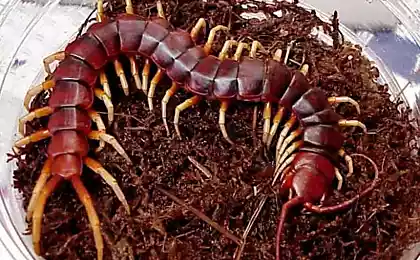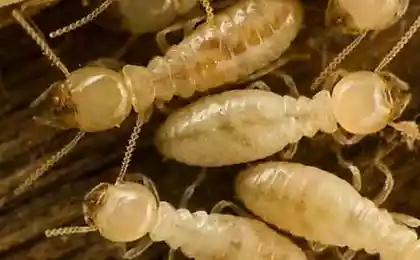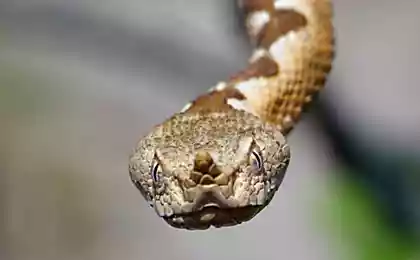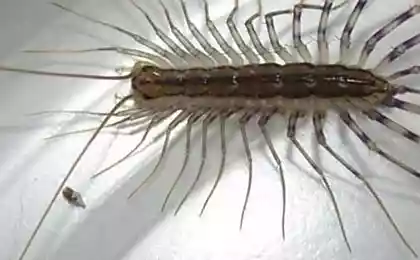4815
Home centipede
The owner of a pet - a weirdo, and on the other can not be.
Who dares to keep his apartment poisonous creature that can hurt just crazy, I think so.

Scolopendra - representative of millipedes, like a long, dark-brown, sometimes with a greenish tinge worm with lots of legs. In Australia and South America inhabited by huge skolopendry purple, red and yellow. Limbs centipedes have a bright orange color. Length - 15 cm. The largest representative skolopendr lives in Australia - a giant centipede, which can grow up to 30 cm. She even attributed the attack on frogs, lizards and chicks.
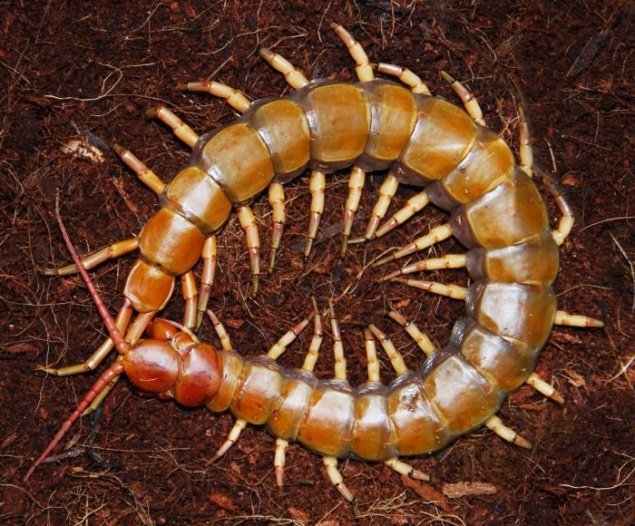
A pair of legs turned all skolopendr in maxilliped with claws connected with poisonous glands. A rear pair - in a special dragging legs that help the animal clinging lumps of soil.

There are about 600 species of centipedes. Basically, it is a tropical species that are the most toxic: burns, obtained from tropical centipedes, can die and adult health. In Russia skolopendry found only in the south, but they are virtually harmless. A lot of centipedes lives in the Crimea, on the Mediterranean and the Caucasus. Dwelling underground, it is quicker than at the surface runs around burrows of other animals or she breaks itself moves through multiple legs. Lives centipede underground, not only because it comfortable there, and because her body is deprived of a special coating and it very quickly loses moisture, under the ground it is not threatened: there remains a constant humidity. All skolopendry thermophilic, temperatures below freezing may simply destroy them.

Hunts centipede on small invertebrates - earthworms, beetles and their larvae, spiders. If it comes to the surface, there can catch wasps and flies. Still centipede prefers living creatures inhabiting underground. During hunting centipede relies on his sense of touch - the main feeling for centipedes. The vision they have poorly developed, or rather that he did not developed, because most of the time they spend in the ground. They only distinguish light and darkness.

Sacrifice centipede missing front legs and plunges into her poisonous maxilliped. Then he starts to chew on, sending pieces of food into a wide throat. Eat slowly and centipede is quite long.

Skolopendr nature individualists, living strictly alone. Fighting between them are rare, but if it happens, it is not a fight for life and death. Opponents cling to each other and freeze in that position, until one of them dies.

Multiply skolopendry in mid-spring. Among them are very common phenomenon partenogineza, that is when the fertilized eggs in the female part itself. A few weeks later, from eggs laid out tiny worms that grow rapidly. Some days the mother protects them, but then she crawls, and every new-found centipede begins independent life. Incidentally, as compared with other insects, these millipedes present centenarians. At least in captivity they live up to 7 years.

Centipede are dangerous to humans, but in different species, this danger is manifested in different ways. For example, representative blind skolopendr - skriptopus - can not bite through the skin, because it has a very weak jaws. But if you crush the centipede, it remains highly toxic. Bird, who inadvertently eats blind centipede dies within a few hours.
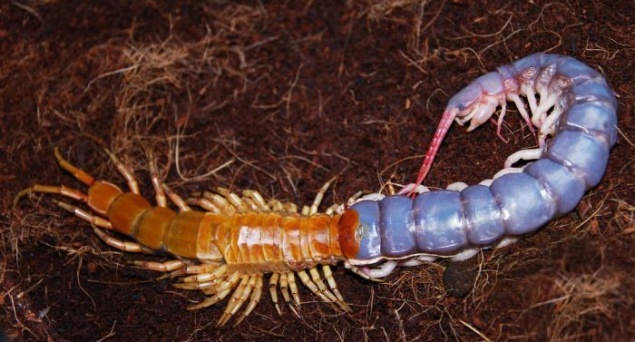
California green centipede, if disturbed, secrete a substance that is very irritating to the skin. Moreover, it can greatly scratched skin if run through the body. By the way, Scolopendra cingulata that lives on the south coast, also leaves burns, in the form of small red spots. However, the burn takes place in a few hours. The Vietnamese centipede mucus with the smell of phosphorus - it causes the most severe burns and skin inflammation.

Call centipede can not be very aggressive. Defensively, centipede can bounce high and deftly move, but burns or bite can be obtained only when the insects take up or centipede itself zabezhit house or tent. In the latter case, the centipede can not notice and accidentally pin. Centipede can run on the human body and does not cause him any harm - it all depends on her own desires. Centipede poison consumed sparingly and rarely bites. Much worse with burning mucus, which is followed by the insect.
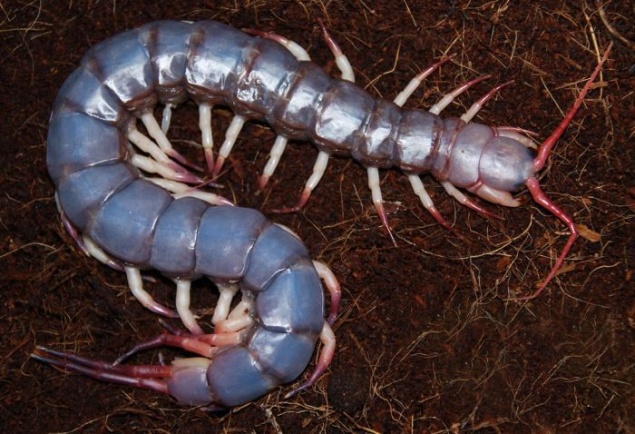
In humans, their bites cause local swelling and pain usually lasts 1-2 hours. If centipede large tropical species, these effects can be kept for several days. In some cases, a fever, fever begins.

For a healthy adult human centipede is not fatal, but causes enormous and flour. But if the victim - a child or, say, a weakened body, a bad heart, the case could end in death.

No measures for first aid in case of a sting or burn poison skolopendry not. You can wipe the affected area of spirits and apply a sterile dressing, but, even if the pain began to subside, it is still mandatory need to go to the nearest hospital, as the symptoms may recur.
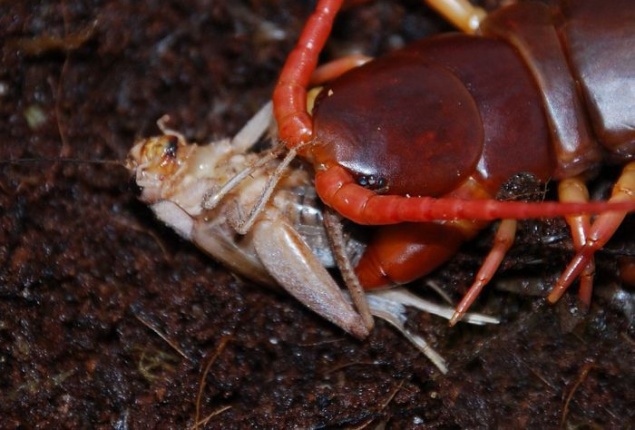
Source: alins.ru
Who dares to keep his apartment poisonous creature that can hurt just crazy, I think so.

Scolopendra - representative of millipedes, like a long, dark-brown, sometimes with a greenish tinge worm with lots of legs. In Australia and South America inhabited by huge skolopendry purple, red and yellow. Limbs centipedes have a bright orange color. Length - 15 cm. The largest representative skolopendr lives in Australia - a giant centipede, which can grow up to 30 cm. She even attributed the attack on frogs, lizards and chicks.

A pair of legs turned all skolopendr in maxilliped with claws connected with poisonous glands. A rear pair - in a special dragging legs that help the animal clinging lumps of soil.

There are about 600 species of centipedes. Basically, it is a tropical species that are the most toxic: burns, obtained from tropical centipedes, can die and adult health. In Russia skolopendry found only in the south, but they are virtually harmless. A lot of centipedes lives in the Crimea, on the Mediterranean and the Caucasus. Dwelling underground, it is quicker than at the surface runs around burrows of other animals or she breaks itself moves through multiple legs. Lives centipede underground, not only because it comfortable there, and because her body is deprived of a special coating and it very quickly loses moisture, under the ground it is not threatened: there remains a constant humidity. All skolopendry thermophilic, temperatures below freezing may simply destroy them.

Hunts centipede on small invertebrates - earthworms, beetles and their larvae, spiders. If it comes to the surface, there can catch wasps and flies. Still centipede prefers living creatures inhabiting underground. During hunting centipede relies on his sense of touch - the main feeling for centipedes. The vision they have poorly developed, or rather that he did not developed, because most of the time they spend in the ground. They only distinguish light and darkness.

Sacrifice centipede missing front legs and plunges into her poisonous maxilliped. Then he starts to chew on, sending pieces of food into a wide throat. Eat slowly and centipede is quite long.

Skolopendr nature individualists, living strictly alone. Fighting between them are rare, but if it happens, it is not a fight for life and death. Opponents cling to each other and freeze in that position, until one of them dies.

Multiply skolopendry in mid-spring. Among them are very common phenomenon partenogineza, that is when the fertilized eggs in the female part itself. A few weeks later, from eggs laid out tiny worms that grow rapidly. Some days the mother protects them, but then she crawls, and every new-found centipede begins independent life. Incidentally, as compared with other insects, these millipedes present centenarians. At least in captivity they live up to 7 years.

Centipede are dangerous to humans, but in different species, this danger is manifested in different ways. For example, representative blind skolopendr - skriptopus - can not bite through the skin, because it has a very weak jaws. But if you crush the centipede, it remains highly toxic. Bird, who inadvertently eats blind centipede dies within a few hours.

California green centipede, if disturbed, secrete a substance that is very irritating to the skin. Moreover, it can greatly scratched skin if run through the body. By the way, Scolopendra cingulata that lives on the south coast, also leaves burns, in the form of small red spots. However, the burn takes place in a few hours. The Vietnamese centipede mucus with the smell of phosphorus - it causes the most severe burns and skin inflammation.

Call centipede can not be very aggressive. Defensively, centipede can bounce high and deftly move, but burns or bite can be obtained only when the insects take up or centipede itself zabezhit house or tent. In the latter case, the centipede can not notice and accidentally pin. Centipede can run on the human body and does not cause him any harm - it all depends on her own desires. Centipede poison consumed sparingly and rarely bites. Much worse with burning mucus, which is followed by the insect.

In humans, their bites cause local swelling and pain usually lasts 1-2 hours. If centipede large tropical species, these effects can be kept for several days. In some cases, a fever, fever begins.

For a healthy adult human centipede is not fatal, but causes enormous and flour. But if the victim - a child or, say, a weakened body, a bad heart, the case could end in death.

No measures for first aid in case of a sting or burn poison skolopendry not. You can wipe the affected area of spirits and apply a sterile dressing, but, even if the pain began to subside, it is still mandatory need to go to the nearest hospital, as the symptoms may recur.

Source: alins.ru

